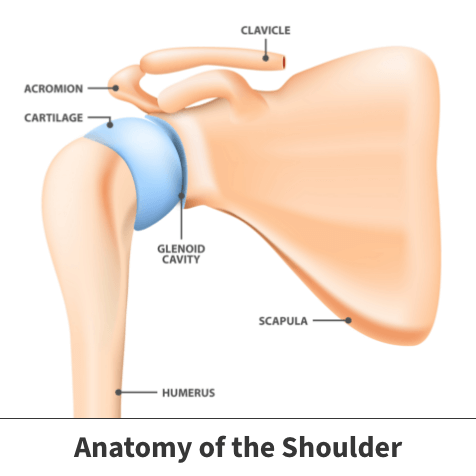Bursitis of the shoulder
Subacromial bursitis
Bursitis of the shoulder is a condition where the fluid-filled sac within the shoulder joint becomes inflamed, resulting in pain and increased difficulty in daily activities. This condition typically does not occur on its own. It usually comes along with rotator cuff tendonitis (the inflammation of the tendons in the shoulder, known as the rotator cuff).
Most cases of bursitis of the shoulder are treated nonsurgically with at-home, simple treatments. Surgery is only recommended when nonsurgical treatments are ineffective.
Anatomy

Your shoulder consists of three bones: your upper arm bone (humerus), your shoulder blade (scapula), and your collarbone (clavicle).
The head of your upper arm bone fits into a rounded socket, known as the glenoid, in your shoulder blade. A combination of muscles and tendons, known as the rotator cuff, keep your arm bone centered in your shoulder socket. The rotator cuff covers the head of your upper arm bone and attaches it to your shoulder blade.
Within the shoulder joint, there are small, fluid-filled sacs known as bursae. Their purpose is to provide a cushion between your joints, which helps reduce friction between the muscles and bones in the joint.
About
Sometimes, excessive use of the shoulder can lead to inflammation and swelling of the bursa located between the rotator cuff and part of the shoulder blade. This bursa is known as the subacromial bursa. When it becomes inflamed, it leads to a condition known as subacromial bursitis.
Bursitis does not commonly occur on its own. It usually comes along with rotator cuff tendinitis (inflammation of the rotator cuff). Regardless, both bursitis of the shoulder and rotator cuff tendinitis result in an increased difficulty in daily activities.
One of the most common causes of bursitis of the shoulder is shoulder impingement. This occurs when the top of the shoulder blade puts pressure on the underlying soft tissues when the arm is lifted away from the body. When the arm is in this position, the top of the shoulder blade rubs (impinges on) the rotator cuff and bursa. This rubbing (impingement) can eventually result in bursitis of the shoulder.
Other causes of bursitis of the shoulder include arthritis, gout, tendonitis, diabetes, infections (very rare), thyroid disease and overuse from playing sports (e.g., pickleball shoulder pain).
Symptoms
There are several symptoms associated with bursitis of the shoulder, including:
- General shoulder and arm pain
- Pain when moving the arm, especially when raising it above the head
- Pain when laying on the shoulder
- Gradual onset of shoulder symptoms over weeks or months

Diagnosis
Your Florida Orthopaedic Institute physician will take a look at your symptoms and perform some manual tests to make sure you have bursitis of the shoulder and not another a different injury or condition.
Additionally, your physician may order some tests to confirm the diagnosis. These tests include:
- Ultrasound scan – This test uses high-frequency sound waves to create an image of part of the inside of the body. It is often the most helpful tool to confirm bursitis of the shoulder.
- MRI – This test uses a strong magnetic field and radio waves to create detailed images of the organs and tissues within the body. It helps show if there is any damage to the rotator cuff or any other surrounding tissues.
Treatment
Nonsurgical treatments are the predominant treatment option for bursitis of the shoulder. Very rarely are surgical procedures recommended for this condition and are only recommended when the nonsurgical treatments are ineffective.
Nonsurgical treatment
There are several, simple at non-surgical treatment options available, including:
- Rest – You’ll need to take a break from all activities or movements that cause you pain.
- Ice – A cold pack on your shoulder will reduce swelling. Aim for 10-15 minutes once or twice a day.
- Over-the-counter pain relief – Medicines like Advil/Motrin (ibuprofen), Aleve (naproxen), or aspirin can ease swelling and soreness.
- Medications – If your pain is intense, your doctor may inject a steroid into the area around your shoulder bursa. This can help manage your pain. If an infection turns out to be the cause of your bursitis, you may need antibiotics.
- Physical therapy and stretching – Some exercises can help your shoulder return to its normal range of motion. Your Florida Orthopaedic Institute physician will show you how to do these exercises. Physical therapy may also be recommended depending on the severity of your condition.
Learn More About Physical Therapy
Surgical treatment
Surgery is rarely ever needed for the treatment of bursitis of the shoulder. If surgery is required, it is typically because the bursitis does not respond to any of the other nonsurgical treatments. The procedure typically consists of removing your bursa so that a new, healthy one can grow in its place. Additionally, sometimes bone is removed to make more room for your rotator cuff tendon, which would help decrease the impingement that may be occurring the shoulder.

Pickleball for seniors: 10 tips for pain-free play
Videos
Related specialties
- AC Joint Injuries
- Atraumatic Shoulder Instability
- Bankart Repair
- Bicep Tenodesis
- Broken Collarbone
- Calcific Tendinitis of the Shoulder
- Clavicle Fractures
- Dislocated Shoulder
- Fractures of the Shoulder Blade (Scapula)
- Glenoid Labrum Tear
- Impingement Syndrome of the Shoulder
- Little League Shoulder
- Reverse Total Shoulder Replacement
- Rheumatoid Arthritis (RA) of the Shoulder
- Rotator Cuff Tears
- Shoulder Arthritis
- Shoulder Arthroscopy
- Shoulder Injury: Pain in the Overhead Athlete
- Shoulder Replacement
- Shoulder Separations
- Shoulder Socket Fracture (Glenoid Fracture)
- SLAP Tears & Repairs
- Subacromial Decompression
- Trapezius Strain (Muscle Strain Of The Upper Back)
- Traumatic Shoulder Instability
